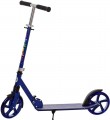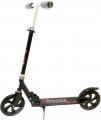Max. load
The maximum weight of the rider that the design of the scooter can withstand without breakdowns and accidents. This point is partly determined by the age group, and mainly by the materials used in the frame (both points below). Note that manufacturers can indicate the maximum load for perfect conditions — when the scooter rides on a perfectly flat surface or even stands still. Therefore, it is worth choosing a model for this parameter with a certain margin; this is especially important for varieties designed for increased loads, in particular scooters and stunt models (see "product type"). Even more so, you should not exceed the weight indicated in the characteristics — even if the scooter does not break down immediately, this can happen at any time after, which is fraught with accidents and injuries.
Age, from
The minimum age at which a child can be entrusted with a scooter. These recommendations are quite approximate, but it is highly not recommended to deviate from them. In the case of electric scooters (see "Type"), it is worth considering that in some countries, to control such devices, you need rights obtained from a certain age; so when buying a similar model, it's ok to clarify the requirements of traffic rules.
The allowable load directly depends on the age group; according to this criterion, modern scooters can be divided into
children's(permissible load up to 50 kg),
teenage(from 50 to 80 kg), and
adults(80 kg or more).
Features
-
Foldable. The ability to fold the scooter — usually by "laying" the handlebar in a horizontal position, on the deck; in some models, the grips of the handlebar are also foldable. This feature greatly simplifies storage and transportation outside business hours. True, folding models are somewhat more expensive and slightly less reliable than clumsy ones, but in many cases, these moments are not critical.
-
Handlebar height adjustment. The ability to change the height of the handlebar, adjusting it to the height of the user. This feature will be especially useful if the scooter is bought for a child for several years: children grow quickly, and every season a higher handlebar height is required. See "Maximum height" for details on height adjustment.
-
Suspension. The scooter has a suspension system — most often on the front wheel. However, there are models with full suspension. In any case, such a system makes the ride more comfortable and smoothes out vibrations, but reduces rolling and control accuracy. Therefore, for example, sports scooters and snow scooters (see "Type") do not have this feature, and it is extremely rare in kickboards.
-
Stand. A device that allows you to put the scooter in a vertical position on any suitable surface without using additional supports — such as walls, benches, fences, et
...c. It is usually carried out in the form of a folding plate or a curly frame under the deck: in the folded state it is raised and does not interfere with movement, and if it is lowered, the scooter acquires an additional point of support.
- Seat. Own seat, allowing you to ride a scooter while sitting. Most often, this function is found in kickboards (see "Type") for the smallest children who are still unable to confidently keep their balance — the seat in such models also serves as fall protection. In addition, by definition, drift models are equipped with a seat.
— Basket on the handlebar. The basket mounted on the handlebars acts as a luggage compartment and can be used to carry various items, such as your favourite toys or a change of clothes. The capacity of the baskets is usually small, but they can provide some convenience. This function occurs mainly in models of the younger age group.
- Bottle holder. A device that provides for the installation of exclusively drinking bottles. This is facilitated by a cylindrical shape, in which such a container will ideally fit, while it will not fall out during the ride. This decision is applicable not so much to children's scooters as to adults, when the scooter is used not for entertainment, but for movement and thirst can overtake at any moment.
- Glowing wheels/deck. The scooter has wheel and/or deck illumination. Glowing wheels are usually made of a transparent polymer with LEDs embedded in them; the deck can be illuminated both on the sides and below. In any case, this function not only provides an original appearance but also makes the scooter more visible, which has a positive effect on safety — especially at dusk and in the dark. The backlight can be powered both by batteries and by a built-in generator that generates energy when the wheels rotate.
- Flashlight / headlight. The presence of a flashlight or headlight in the scooter. This function will be useful, especially in twilight and darkness: it provides illumination of the road and also makes the scooter more visible to other road users.
— Signal/bell. The presence of a bell or other sound signal (for example, a horn) in the kit. Such a device is useful for warning others about the movement of the scooter, it allows you to avoid unpleasant incidents.
- Pegs. Devices on the wheels of sports scooters that allow you to perform various trick exercises, namely, to slide along curbs, railings, etc. It is an additional stop that is installed in the wheel axle of the scooter and can be used not only as a fulcrum for the foot but also as a support when driving over various obstacles (railings, ramps, etc.). As a rule, scooters for stunt/sports riding are equipped with pegs. At the same time, they can be equipped with both the front and rear wheels and in some cases, the peg is installed on both the right and left sides of the wheel.
- Parent handle. A long handle is mounted on some kickboards so that an adult can comfortably hold on to it while standing next to it. Thus, the parent can, to a certain extent, control the movement of the child, stop him at the right time or vice versa, push, or even carry the baby, like in a stroller. Such a solution is relevant for models with a seat and for children who are not yet capable of independent movement on a scooter.Max. height
The maximum height to which the height-adjustable handlebar can be set (or just the height of the handlebar in the working position, if height adjustment is not provided).
The height of the handlebars should be such that the rider can stand on the deck straight, without bending his back, and hold on to the handles with slightly bent arms. At the same time, there is no unambiguous relationship between this parameter and the height of the rider. So the perfect option to determine the optimal height is to try it yourself, and then choose a scooter based on the result.
Deck size
Scooter deck size. This item can indicate both the length and width or only one size — most often this is the length.
In general, this parameter is secondary: manufacturers choose the size of the deck depending on the type, age category, general specialization and other features of the scooter. Legroom, usually, is guaranteed to be enough on the deck. We only note that shorter decks are more agile, and longer ones are stable on the course.

